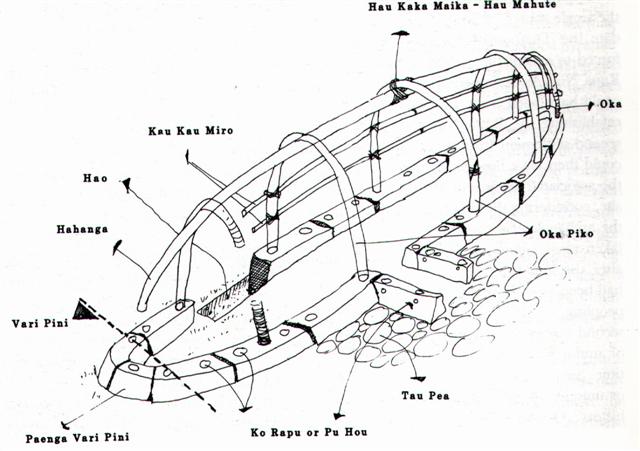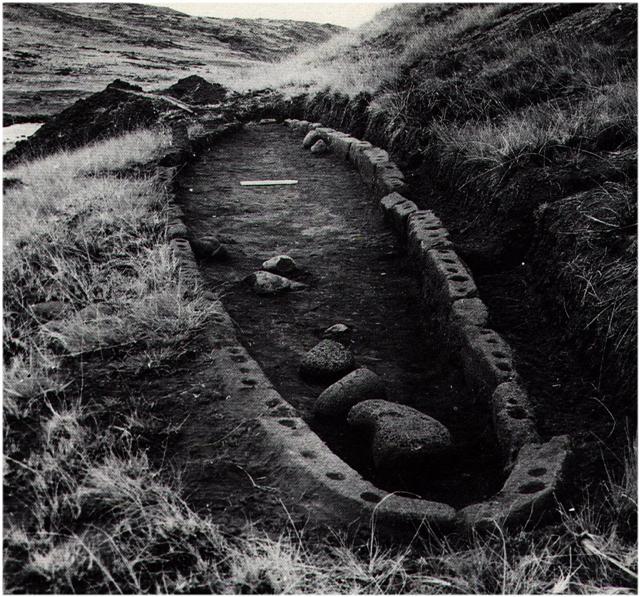The pair Hau Maka and Hua Tava were located at opposite corners of the house,
and they had sons who were entrusted with the task of sailing to Easter Island.
All sorts of food (anakeanake te kai) were pressed into the canoe (he ngatu ki roto ki te vaka), but 4 kinds were singled out as specially noteworthy, possibly because they could represent the 4 quarters in a year:
The sailing vessel was a canoe - te vaka - which perhaps might be contrasted with another kind, viz. te miro:
Miro. 1. Wood, stick; also (probably improperly) used for 'tree': miro tahiti, a tree from Tahiti (Melia azedarach); miro huru iti, shrub. 2. Wooden vessel (canoe, boat); today pahú (a Tahitian word) is more used, especially when speaking of modern boats. 3. Name of the tribe, of royal blood, descended from Ariki Hotu Matu'a. Vanaga. Miro-oone, model boat made of earth in which the 'boat festivals' used to be celebrated. Vanaga. ... on the first day of the year the natives dress in navy uniforms and performs exercises which imitate the maneuvers of ships' crews ... Métraux. Tree, plant, wood, plank, ship, building; miro hokuhoku, bush, thicket; miro takataka, bush; miro tupu, tree; miro vavau, switch. Miroahi, firebrand. Mimiro, compass, to roll one over another, to turn in a circle. P Pau.: miro, to rope. Churchill. 1. Wood. 2. Ship (Ko te rua o te raa i tu'i ai te miro ki Rikitea tupuaki ki Magareva = On the second day the boat arrived at Rikitea which is close to Mangareva. He patu mai i te puaka mo ma'u ki ruga ki te miro = They corralled the cattle in order to carry them on to the boat.) Krupa. T. 1. The tree Thespesia populnea. ... a fine tree with bright-green heart-shaped leaves and a yellow flower resembling that of the fau, but not opening wide. The fruit is hemispherical and about twice the size of a walnut, consisting of brittle shell in which are several septa, each containing a single seed. The wood resembles rosewood and is of much the same texture. Formerly, this tree was held sacred. Henry. 2. Rock. (To'a-te-miro = Long-standing-rock.) Henry. Vaka. Canoe, small boat; vaka ama, outrigger canoe. Vaka-ivi, graves under ahu which hold skeletons (lit. 'bone canoe'). Vaka-ure, to lay foundation stones in the outline of a canoe (e.g. for hare paenga); nowadays used in the more general sense, without reference to a special shape of outline. Vanaga. Canoe, boat, bateau, shallop, barge. Vakapoepoe (vaka - poepoe) boat. P Pau.: vaka, canoe. Mgv.: vaka, canoe, raft. Mq.: vaka, canoe. Ta.: vaa, canoe, boat. Vakavaka, narrow. Mq.: vakavaka, vaávaá, small, fine, thin. Churchill.
... It is certainly true that the exterior form of the hare paenga, when the superstructure and thatch are intact, resembles an overturned boat, with the form established by the foundation. However, it is equally true (and perhaps equally important) that the configuration of the foundation is otherwise most like the Rapa Nui vulva design called komari. Ships are always considered to be female. |
|||||||||||||||||||||||||||||||||||||||||||

